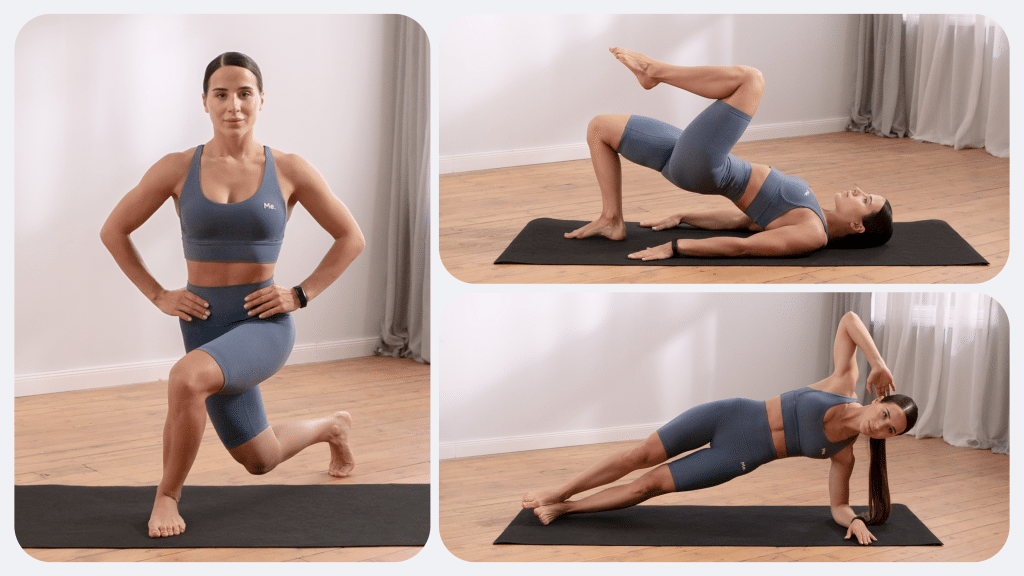Designing a strength training program can feel like solving a puzzle with missing pieces. There’s advice flying at you from every corner—your gym partner swears by endless biceps curls, while an online influencer is preaching about “secret” exercises that promise instant gains. Add confusing jargon like “progressive overload” and “periodization,” and you end up wanting to “wing it.”
Here’s the thing, though—strength training isn’t that complicated. The science behind building muscle, improving strength, and enhancing overall fitness is surprisingly straightforward. When you strip away the noise, what’s left are a few key principles anyone can understand and follow.
This guide is your practical, no-frills roadmap to building an effective program without wasting time or energy.
Whether you’re looking to:
- Bulk up
- Get toned
- Lift heavier
- Improve your health
We’ll break down what works, what doesn’t, and how to apply it to your routine.
What Is A Good Strength Training Program?
A good program is grounded in science and shaped around your personal goals.
It focuses on the essentials and avoids unnecessary complexity. It also respects that each person’s body, schedule, and abilities are unique. Let’s break it down.
1. Personalization Is Key
No one-size-fits-all plan will work for everyone. A good program considers your current fitness level, goals, and limitations:
- Are you training to lift heavy?
- Improve muscle size (hypertrophy)?
- Boost overall fitness?
The answer will guide your program design.
For example:
- If your goal is strength, you’ll focus on heavier weights with fewer reps (3–6 per set).
- Moderate weights with more reps (6–12 per set) work best if you aim for muscle growth.
- Lighter weights and higher reps (12–20) are more effective for endurance.
Your schedule and recovery ability also matter.
You’ll need full-body sessions if you can train 3x a week.
You can split by muscle groups or movement patterns for 5 weekly sessions.
2. It Revolves Around Progressive Overload
Progressive overload is the backbone of any good program. This principle means gradually increasing the stress on your muscles over time—so they grow stronger and adapt (1).
It’s as simple as:
- Adding a bit more weight.
- Doing an extra rep or set.
- Improving your lifting technique.
Without progressive overload, your body won’t get stronger, and you may hit a plateau.
This concept isn’t flashy, but it works.
3. Compound Movements Take Priority
A good strength program focuses on compound exercises. These movements work multiple muscle groups simultaneously, such as squats, deadlifts, bench presses, pull-ups, and rows (2).
Why compound exercises?
Because they:
- Build strength efficiently.
- Recruit more muscles, giving you more bang for your buck.
- Mimic real-life, functional movement patterns.
While you can include isolation exercises (like bicep curls), they should take the back seat to compound movements if your goal is overall strength.
BetterMe will keep you laser-focused on your weight loss journey! Nutrient-packed meal plans, fat-blasting workouts, galvanizing challenges and much more. Try using the app and see for yourself!
4. Include A Balanced Movement Pattern
Strength training isn’t just about lifting heavy weights.
An excellent program balances all major movement patterns:
- Push (e.g., bench press, push-ups)
- Pull (e.g., pull-ups, rows)
- Squat (e.g., barbell squats, goblet squats)
- Hinge (e.g., deadlifts, hip thrusts)
- Core (e.g., planks, ab rollouts)
Balancing these ensures full-body strength and reduces the risk of injury.
It also avoids imbalances, which can lead to pain or limited progress.
5. Rest And Recovery Matter
Muscles grow when you rest, not when you train (3). A good program builds recovery into the plan:
- Allow 48 hours between training the same muscle group.
- Include at least 1-2 weekly rest days.
- Sleep 7–9 hours each night to support muscle repair.
Overtraining slows progress and increases injury risk (4).
Listen to your body and honor your recovery needs.
6. Track And Adjust Regularly
No plan is perfect forever. Over time, your body will adapt, and your program must evolve.
Keep a log of your workouts, noting weights, sets, and how you felt.
This logging process helps you:
- Spot progress.
- Identify where you’ve plateaued.
- Make changes when needed.
Swap in new exercises after 6–8 weeks, or adjust your sets and reps to revitalize your progress and keep things interesting.
7. Consistency Over Perfection
A great program only works if you stick to it. Consistency is what turns hard work into results. Even if your plan isn’t textbook perfect, showing up week after week matters more. Focus on progress, not perfection.
8. Science-Based Programming Principles
A good program respects evidence-based practices. The science means no gimmicks, shortcuts, or fads.
Stick to proven methods:
- Lift weights at an intensity that feels challenging (but safe).
- Warm up before starting to prepare your muscles.
- Stretch or cool down to aid recovery and flexibility.
Forget the myths—like needing to train to fail all the time or that a strength training program for women will make you “bulky” from lifting heavy weights.
An innovative, scientific approach gets results without the fluff.
Read more: How to Lose 100 Pounds in a Year Without Risking Your Health
What Exercises Should A Strength Training Program Include?
A solid strength training program isn’t one-dimensional. Each type of exercise fits into the bigger picture:
- Strength and core exercises lay the foundation of power and stability.
- Flexibility and mobility work support a better range of motion, lifting form, and recovery.
- Power exercises help you build explosiveness for functional and athletic benefits.
- Cardio ensures you stay fit, energized, and heart-healthy.
1. Strength And Resistance Exercises
These are the backbone of any strength training program.
Strength exercises focus on building muscle and improving your ability to lift, push, and pull. They revolve around working against resistance, whether your body weight, dumbbells, barbells, or resistance bands.
- Compound exercises (multiple joints and muscle groups): Squats, deadlifts, push-ups, bench presses, rows, and pull-ups. These moves give you the most bang for your buck by working several muscles simultaneously.
- Isolation exercises (single joint, targets one muscle): Bicep curls, tricep extensions, leg curls, and lateral raises. These are great for addressing weaknesses or adding volume to specific areas.
Strength exercises build muscle and improve bone density and functional fitness (5).
Aim for a mix of compound and isolation exercises to maximize efficiency and balance (6).
Discover Super Slow Strength Training to maximize muscle growth and efficiency with minimal risk of injury.
2. Flexibility And Mobility Exercises
Flexibility and mobility allow you to move freely, reduce stiffness, and prevent injuries (7).
While they might not seem as exciting as lifting heavy, they’re the unsung heroes of a successful strength program.
- Dynamic stretches (done before workouts): Leg swings, arm circles, and walking lunges.
These prepare your muscles and joints for movement.
- Static stretches (held for a time, done after workouts): Hamstring stretches, chest stretches, or child’s pose.
These improve flexibility over time.
- Mobility drills (combine strength and movement): Hip openers, thoracic rotations, or shoulder dislocates.
These enhance joint range of motion for better performance and technique.
Flexibility and mobility exercises keep your body resilient and help you train pain-free.
Ensure they’re a regular part of your routine.
3. Core And Stability Exercises
Core training goes beyond crunches. A strong core stabilizes your body, improves posture, and translates to better strength in other lifts (8). Stability exercises train your smaller, stabilizing muscles, reinforcing your ability to control movement.
Examples of core exercises:
- Planks
- Ab rollouts
- Woodchoppers
- Hanging leg raises
Examples of stability exercises:
- Single-leg deadlifts
- Turkish get-ups
- Balance work
These movements build strength from the inside out, allowing for better movement and lifting mechanics.
Our previous blog on Core Structural Exercises explores techniques to strengthen your foundation for better overall fitness.
4. Power And Explosive Movements
These exercises train your ability to move forcefully and quickly. They’re excellent for athletes but can benefit anyone looking to improve coordination and overall athleticism (9).
Examples of power exercises include:
- Cleans
- Box jumps
- Kettlebell swings
- Push presses
Power exercises recruit your fast-twitch muscle fibers, essential for speed and strength.
Incorporate them after your warm-up when your energy levels are highest.
5. Cardio And Endurance Exercises
Though not traditionally considered strength training, cardio plays a role in heart health, endurance, and recovery (10).
Different modes of cardio can complement your program depending on your goals.
- Steady-state cardio (e.g., cycling, jogging): Builds baseline endurance and complements lower-intensity days.
- High-intensity interval training (HIIT): Alternates intense bursts with rest.
Adds intensity while preserving muscle mass.
Cardio prevents your program from becoming one-dimensional. It aids recovery and keeps your heart in peak condition.
Should You Add Cardio To A Strength Program?
Adding cardio to a strength program can be smart, depending on your goals.
Cardio and strength training serve different purposes but complement each other well.
Cardio has the following benefits:
- Improves cardiovascular health
- Boosts endurance
- Burns calories (10)
These benefits are helpful if your goals involve losing fat or improving stamina.
On the other hand, strength training:
- Builds muscle
- Increases bone density
- Enhances functional strength (5)
Including cardio can aid recovery by promoting blood flow to your muscles and reducing soreness (11). Light cardio sessions, like walking or cycling, fit well on active recovery days or after a strength session. High-intensity interval training (HIIT) can improve fitness and maintain muscle mass while adding a metabolic challenge (12).
However, excessive cardio—such as long, intense sessions—can interfere with muscle recovery and growth (13), mainly if it eats into your energy reserves or recovery time.
It’s about balance. Strength should remain the focal point of your program if building muscle and strength is your primary goal. Use cardio strategically to support those goals, not work against them.
How To Create Your Strength Training Program?
Designing your strength training program can feel like a hurdle, but it doesn’t have to.
Following a series of straightforward steps can create a balanced and effective plan tailored to your personal goals.
Here’s how to create a strength training program that fits your life:
Step 1. Define Your Goal
Start by asking yourself what you want to achieve. Do you want to get stronger, build muscle, lose fat, or simply feel healthier? Your goal will shape every aspect of your program.
For example:
- Strength-focused programs emphasize heavy lifting with lower reps.
- Muscle-building (hypertrophy) programs use moderate weights with higher reps.
- General fitness programs combine strength and endurance training.
Knowing your goal gives you clarity and direction when deciding on exercises, reps, and sets.
Step 2. Decide How Often You’ll Train
Your schedule dictates what’s realistic. Be honest about how often you can commit to strength training.
- 2–3 days/week? Full-body workouts are ideal. You’ll train all major muscle groups in each session.
- 4–5 days/week? A split routine works well. You can focus on specific muscle groups or movement patterns daily (e.g., upper body, lower body, push/pull).
Pick a frequency you can stick to consistently. Consistency beats perfection every time.
Step 3. Choose Your Exercises
To keep things simple, start with the basics. Pick compound exercises as your foundation.
These should cover all the major movement patterns:
- Push: Bench press, push-ups.
- Pull: Pull-ups, barbell rows.
- Squat: Front squats, goblet squats.
- Hinge: Deadlifts, Romanian deadlifts.
- Core: Planks, hanging leg raises.
Once these are in place, you can add isolation exercises (like bicep curls or tricep extensions) if time allows. A balanced mix of movements ensures full-body strength and reduces injury risk.
Be wary of exercise redundancy. Exercise redundancy occurs when a program includes multiple exercises that target the same muscle groups similarly. While variety is critical to a balanced program, too much overlap can waste time and energy without delivering additional benefits.
For example, including bench presses and push-ups in a program may offer little benefit, as both exercises primarily target the chest and triceps.
Instead, pair a compound lift like the bench press with an isolation exercise like tricep dips to work the muscles from different angles. Or perform the bench press on one day and push-ups on another to increase volume without redundancy.
BetterMe is your fast-track ticket to long-lasting weight loss! Tailor your fitness journey and maximize your results with just a couple of swipes!
Step 4. Plan Your Sets, Reps, And Weight
Your sets, reps, and the weight you lift depend on your goal:
- Strength: 3–6 sets of 3–6 reps at heavier weights (around 75–90% of your 1-rep max).
- Hypertrophy: 3–4 sets of 6–12 reps at moderate weights (around 65–75% of your max).
- Endurance: 2–4 sets of 12–20 reps with lighter weights (below 65% of your max).
Start conservatively, especially if you want a strength training program for beginners.
Use weights you can lift with good form while feeling challenged. Over time, apply progressive overload (e.g., increasing weight or reps) to keep progressing.
Step 5. Factor In Rest And Recovery
Rest is where the magic happens. Plan enough rest between exercises and workouts to recover fully and avoid overtraining.
- Rest for 1–3 minutes between sets, depending on the intensity.
- Allow at least 48 hours between workouts before training the same muscle group again.
- Include rest days or active recovery (light walking, stretching) in your weekly schedule.
Recovery isn’t slacking—it’s an essential part of building strength.
Step 6. Warm-Up And Cool Down
A proper warm-up preps your body for the lifts ahead. Spend 5–10 minutes on dynamic stretches or light cardio to increase blood flow (14). Perform a few lighter sets of the exercise before going heavy.Don’t skip the cooldown, either. Stretching after your session helps your muscles recover and maintain flexibility, reducing soreness (15).
Step 7. Track Your Progress
Keep a training log. Write down your exercises, how much weight you used, and how many reps/sets you completed.
This tracking habit helps you:
- Spot progress (or plateaus).
- Know when to increase weight or adjust your plan.
- Stay consistent by tracking how often you train.
Treat this log as your personal fitness story—it will motivate you as you watch your hard work pay off.
Step 8. Evaluate And Adjust Over Time
Even the best plan needs fine-tuning. After 6–8 weeks, assess what’s working and where you need improvements.
Feeling stronger? Increase the weights.
Bored? Swap in a new set of exercises.
Stuck? Try adjusting your rep ranges or sets.Your program should evolve as you do. Be flexible and willing to change based on how your body feels and the results you’re seeing.
Read more: The Fastest Way to Lose 100 Pounds – A Sustainable Approach
How Long Does It Take To See Results From Strength Training?
The timeline for seeing results from strength training varies based on several factors.
Typically, you can expect to notice improvements in strength within 2-4 weeks of consistent training.
Muscle growth, or hypertrophy, usually becomes visible after 6-8 weeks, depending on factors like training intensity, diet, and genetics (16). For endurance and stamina, improvements can start within a few weeks as your body adapts to physical demands.
Training regularly, following proper form, and using progressive overload are critical for progress. The quality of your nutrition, sleep, and recovery also significantly affect how quickly you see results.
How Do You Progress In A Strength Training Program?
Your strength training program will advance through progressive overload.
This advancement means gradually increasing the challenge on your muscles by adding more weight, increasing reps, doing more sets, or reducing rest time between sets. This progression ensures your body adapts and strengthens over time (1).
Other variables you can adjust for progressive overload include:
- Exercise Selection: Changing exercises target muscles differently, helping you avoid adaptation and stimulate new growth (17). Rotate variations of squats, presses, or pulls to keep your routine fresh.
- Tempo: Adjusting the speed of your lifts can increase time under tension and improve control. Slower tempos challenge muscles differently, while explosive tempos build power (18).
- Training Frequency: Adding more sessions per week or revisiting specific muscle groups more often can accelerate progress (19). Be cautious about balancing intensity and recovery.
- Rest Periods: Shortening rest between sets increases intensity and endurance (20), while longer rests allow you to lift heavier and focus on strength (21). Adjust based on your goals.
- Training Volume: Increasing the reps or sets for an exercise boosts workload over time, challenging your muscles to adapt further (22).
- Exercise Order: Starting with compound movements before isolations maximizes strength potential (23). Reordering exercises can also create new challenges for your body.
- Grip or Stance Variations: Changing hand placements or foot positions can alter muscle activation (24), helping you address weaknesses or hit muscles from different angles.
Adjusting these variables can add variety, prevent stagnation, and ensure well-rounded progress.
What Are Common Mistakes In A Strength Training Program?
Some common mistakes to avoid when designing a strength training program are:
- Poor Form: Lifting with improper technique increases the risk of injury and limits progress (25).
- Skipping Warm-ups: Neglecting to prepare your body increases the chance of injury and reduces performance (14).
- Overtraining: Training too frequently or with insufficient recovery leads to burnout and stalled progress (3).
- Lack of Consistency: Irregular workouts hinder improvement and make progress harder to track (19).
- Neglecting Recovery: Failing to prioritize sleep, nutrition, and rest limits muscle repair and growth (3).
- Ignoring Progressive Overload: Sticking to the same weights and reps prevents ongoing strength gains (1).
- Unbalanced Programming: Focusing solely on specific muscle groups while neglecting others creates strength imbalances.
- Rushing Progression: Increasing weight or volume too quickly can lead to poor form and injuries.
- Insufficient Warm-ups for Heavy Lifts: Attempting max-effort lifts without proper preparation decreases performance and can cause potential injuries (14).
- Ignoring Mobility and Flexibility: Neglecting these aspects limits the range of motion and increases the risk of injury (7).
- Improper Rest Periods: Resting too long can lead to lost intensity while resting too little can hurt performance.
- Not Tracking Progress: It’s hard to assess results or make effective adjustments without tracking.
- Poor Nutrition: Eating too little or consuming the wrong foods will negatively impact strength and recovery.
- Failing to Set Clear Goals: Training without specific objectives makes progress slower and less focused.
- Comparing Yourself to Others: Chasing someone else’s program or pace can lead to overreaching and frustration.
- Neglecting Mental Focus: Distractions or lack of concentration during lifts can affect performance and increase accident risks.
A strength training program for weight loss can build lean muscle, increasing your resting metabolic rate. It also burns calories during workouts and improves overall body composition. When done correctly, strength training is safe for people of all ages, such as children and older adults (including strength training over 40 female at home-workouts). We should tailor these programs to the individual’s fitness level and needs. No, you don’t need a gym. You can use bodyweight exercises, resistance bands, or free weights like dumbbells in a strength training program at home. Set clear goals, track your progress, and establish a routine. Mixing up exercises, celebrating small wins, and finding a workout partner can also help maintain motivation.Frequently Asked Questions
Can strength training help with weight loss?
Is strength training safe for all ages?
Do you need a gym for a strength training program?
How do you stay motivated to train consistently?
The Bottom Line
A well-designed strength training program is the foundation for building strength, improving overall fitness, and reaching your health goals. You can maximize results while staying injury-free by focusing on balanced exercise selection, proper progression, and avoiding common pitfalls like exercise redundancy.
DISCLAIMER:
This article is intended for general informational purposes only and does not serve to address individual circumstances. It is not a substitute for professional advice or help and should not be relied on for making any kind of decision-making. Any action taken as a direct or indirect result of the information in this article is entirely at your own risk and is your sole responsibility.
BetterMe, its content staff, and its medical advisors accept no responsibility for inaccuracies, errors, misstatements, inconsistencies, or omissions and specifically disclaim any liability, loss or risk, personal, professional or otherwise, which may be incurred as a consequence, directly or indirectly, of the use and/or application of any content.
You should always seek the advice of your physician or other qualified health provider with any questions you may have regarding a medical condition or your specific situation. Never disregard professional medical advice or delay seeking it because of BetterMe content. If you suspect or think you may have a medical emergency, call your doctor.
SOURCES:
- Progression of volume load and muscular adaptation during resistance exercise (2014, nih.gov)
- 5 Benefits of Compound Exercises (2016, acefitness.org)
- How often should you take a rest day? (2023, ucla health.org)
- Musculoskeletal adaptations and injuries due to overtraining (1992, nih.gov)
- Resistance training – health benefits (2022, betterhealth.vic.gov.au)
- Single vs. Multi-Joint Resistance Exercises: Effects on Muscle Strength and Hypertrophy (2015, nih.gov)
- The Importance of Flexibility and Mobility (n.d., psu.edu)
- Why do we need a strong core? (2023, getactive.vic.gov.au)
- Effectiveness of plyometric training vs. complex training on the explosive power of lower limbs: A Systematic review (2023, frontiersin.org)
- Cardiovascular benefits of exercise (2012, nih.gov)
- A Systematic Review on the Effectiveness of Active Recovery Interventions on Athletic Performance of Professional-, Collegiate-, and Competitive-Level Adult Athletes (2019, journals.lww.com)
- Evidence-Based Effects of High-Intensity Interval Training on Exercise Capacity and Health: A Review with Historical Perspective (2021, mdpi.com)
- Exercise-Induced Muscle Damage after a High-Intensity Interval Exercise Session: Systematic Review (2023, mdpi.com)
- Revisiting the ‘Whys’ and ‘Hows’ of the Warm-Up: Are We Asking the Right Questions? (2024, springer.com)
- Do We Need a Cool-Down After Exercise? A Narrative Review of the Psychophysiological Effects and the Effects on Performance, Injuries and the Long-Term Adaptive Response (2018, springer.com)
- Adaptations to Endurance and Strength Training (2018, nih.gov)
- The role of exercise selection in regional Muscle Hypertrophy: A randomized controlled trial (2021, nih.gov)
- The Influence of Movement Tempo During Resistance Training on Muscular Strength and Hypertrophy Responses: A Review (2021, springer.com)
- Effects of Resistance Training Frequency on Measures of Muscle Hypertrophy: A Systematic Review and Meta-Analysis (2016, springer.com)
- Higher Muscle Damage Triggered by Shorter Inter-Set Rest Periods in Volume-Equated Resistance Exercise (2022, frontiersin.org)
- Longer Interset Rest Periods Enhance Muscle Strength and Hypertrophy in Resistance-Trained Men (2016, journals.lww.com)
- Resistance Training Volume Enhances Muscle Hypertrophy but Not Strength in Trained Men (2019, journals.lww.com)
- Maximizing Muscle Hypertrophy: A Systematic Review of Advanced Resistance Training Techniques and Methods (2019, mdpi.com)
- The Effect of Foot Position and Angle in Squats and Hack Squats on Quadriceps Muscle Activation (2024, researchgate.net)
- ~Benefits of Proper Form and Technique during~Resistance Training~ (n.d., walkitscience.org)










